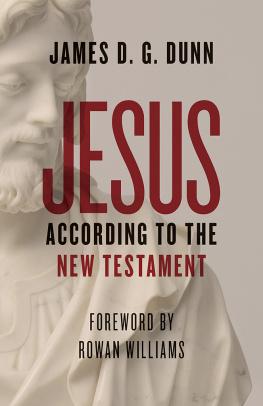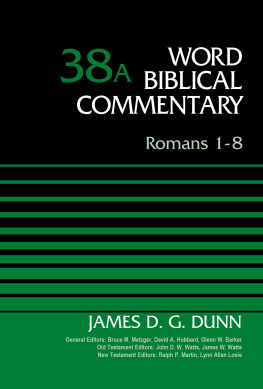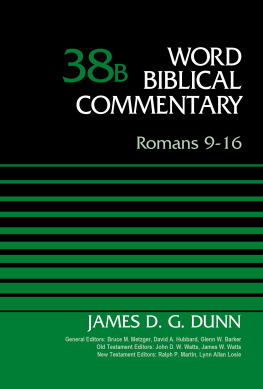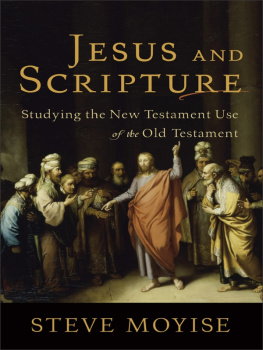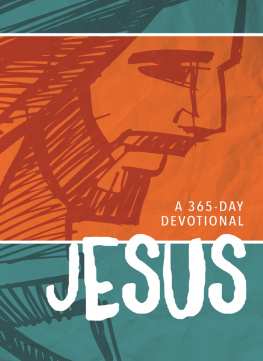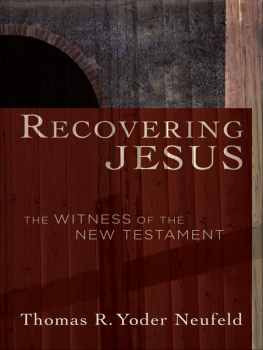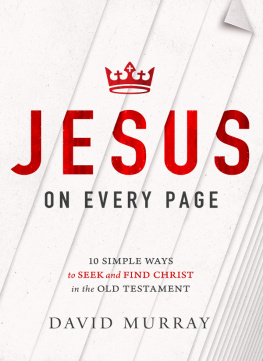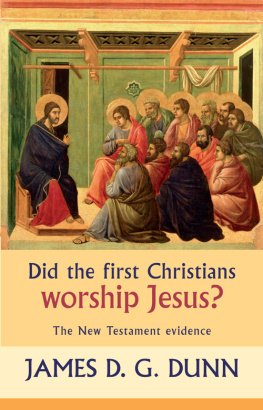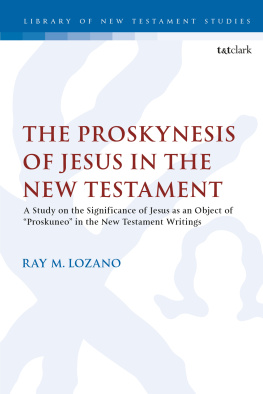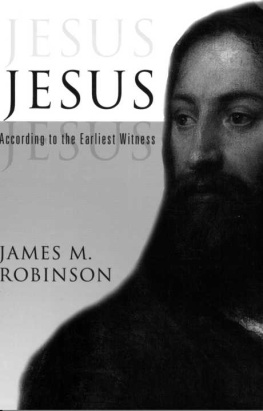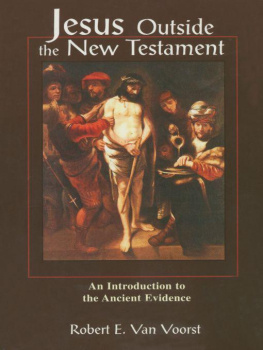James D. G. Dunn - Jesus according to the New Testament
Here you can read online James D. G. Dunn - Jesus according to the New Testament full text of the book (entire story) in english for free. Download pdf and epub, get meaning, cover and reviews about this ebook. year: 2019, publisher: Eerdmans, genre: Religion. Description of the work, (preface) as well as reviews are available. Best literature library LitArk.com created for fans of good reading and offers a wide selection of genres:
Romance novel
Science fiction
Adventure
Detective
Science
History
Home and family
Prose
Art
Politics
Computer
Non-fiction
Religion
Business
Children
Humor
Choose a favorite category and find really read worthwhile books. Enjoy immersion in the world of imagination, feel the emotions of the characters or learn something new for yourself, make an fascinating discovery.
- Book:Jesus according to the New Testament
- Author:
- Publisher:Eerdmans
- Genre:
- Year:2019
- Rating:3 / 5
- Favourites:Add to favourites
- Your mark:
- 60
- 1
- 2
- 3
- 4
- 5
Jesus according to the New Testament: summary, description and annotation
We offer to read an annotation, description, summary or preface (depends on what the author of the book "Jesus according to the New Testament" wrote himself). If you haven't found the necessary information about the book — write in the comments, we will try to find it.
New Testament scholar James D. G. Dunn has published his research on Christian origins in numerous commentaries, books, and essays. In this small, straightforward book designed especially for a lay audience, Dunn focuses his fifty-plus years of scholarship on elucidating the New Testament witness to Jesus, from Matthew to Revelation. Dunns Jesus according to the New Testament constantly points back to the wonder of those first witnesses and greatly enriches our understanding of Jesus.
Jesus according to the New Testament — read online for free the complete book (whole text) full work
Below is the text of the book, divided by pages. System saving the place of the last page read, allows you to conveniently read the book "Jesus according to the New Testament" online for free, without having to search again every time where you left off. Put a bookmark, and you can go to the page where you finished reading at any time.
Font size:
Interval:
Bookmark:

JESUS ACCORDING TO
THE NEW TESTAMENT
James D. G. Dunn
WILLIAM B. EERDMANS PUBLISHING COMPANY
GRAND RAPIDS, MICHIGAN
Wm. B. Eerdmans Publishing Co.
4035 Park East Court SE, Grand Rapids, Michigan 49546
www.eerdmans.com
2019 James D. G. Dunn
All rights reserved
Published 2019
2827262524232221201912345678910
ISBN978-0-8028-7669-0
eISBN978-1-4674-5254-0
Library of Congress Cataloging-in-Publication Data
Names: Dunn, James D. G., 1939- author.
Title: Jesus according to the New Testament / James D. G. Dunn.
Description: Grand Rapids : Eerdmans Publishing Co., 2019. | Includes bibliographical references and index.
Identifiers: LCCN 2018024862 | ISBN 9780802876690 (pbk. : alk. paper)
Subjects: LCSH: Jesus Christ.Person and officesBiblical teaching. | Bible. New TestamentCriticism, interpretation, etc.
Classification: LCC BT203 .D859 2019 | DDC 232dc23
LC record available at https://lccn.loc.gov/2018024862
For St. Pauls Church,
Chichester, and the Chichester Diocese
Contents
R eaders of the New Testament in Christian congregations (and among a wider public too) are quite likely these days to feel a certain amount of bewilderment at the variety and complexity of what is written on the subject. Those who venture a little into the scholarly literature, as well as those who pick up the latest sensational stories in the media about lost gospels and alternative histories, may feel like echoing Mary Magdalene: They have taken away my Lord, and I do not know where they have laid him. What do wewhat can wereally know about Jesus? Is the New Testament just the deposit of a confused mass of unreliable traditions, put together under the iron hand of a narrow church authority?
Professor Dunn, one of the most respected and prolific biblical scholars of our time, with a long string of innovative, comprehensive studies of the New Testament text to his name, begins with a simple but all-important question in this book. It is really a commonsensical one: What must have been going on in the life, and indeed in the mind, of Jesus for any of the New Testament texts to have been possible? To ask such a question does not mean that everything we read in the New Testament is a straightforward record of events or that the ideas of the first believers are immediately accessible to us. But it does remind us that the movement whose writings we read in the canonical Gospels, Acts, and letters began with the narrative of a specific historical figure whose words and actions were sufficiently different from the norm to attract attention.
Like some other scholars in recent years, Professor Dunn is skeptical about the skepticism that has prevailed in a fair amount of learned discussion. If certain things had not been true about Jesus, it is simply very hard to see how certain kinds of text and certain kinds of talk would ever have emerged. Many writers have stressed that there are aspects of the gospel stories that seem to be preserved even though the earliest churches did not fully understand themlike Jesuss description of himself as Son of Man or the whole way he is remembered as speaking about Gods kingdom. If he never said a word about how he understood the death he knew he was risking, it would be hard to see why and how the quite dense and complicated language used to interpret baptism and the Lords Supper got started. Andmost simply of all, a point well brought out by Professor DunnJesus was remembered as a storyteller in a way that is not true of any other figure in the New Testament and that is rare among his Jewish contemporaries. The parables are among the most plainly distinctive things in the traditions about Jesus, and they tell us something of his understanding of the relation between the everyday and the holy which is still radical.
The New Testament is tantalizing for readers because its texts are both startlingly different from one another and startlingly convergent. Just this mixture of difference and convergence is exactly what should make us pause before accepting the fashionable idea that what we have in the New Testament is some sort of unrepresentative selection of writings which just happened to be acceptable to dictatorial prelates in the early centuries. With exemplary clarity and understated scholarly acumen, Professor Dunn traces both the continuities between these diverse texts and the communities that used them, and the discontinuities, the local emphases and sometimes controversial new twists to the story that developed in some quarters. Many readers will find it liberating to realize that to believe in the consistency of the New Testament is not the same as having to suppose that every writer says the same thing. From the very first, what happens in and around the figure of Jesus is experienced as too immense to be communicated in one telling, seen from one perspective; as the end of Johns Gospel already says so eloquently, the world could not contain all that would need to be said.
So this survey of what the story of Jesus meant in the first Christian generations becomes a powerful theological testimony to the scale of the mystery laid bare in those events. This is a book that will nurture a faith that is not uncritical but is also being directed constantly back toward the wonder of the first witnesses. It is as we make that wonder our own that our faith grows and deepens; Professor Dunn helps us toward that enrichment of joy, trust, and gratitude.
ROWAN WILLIAMS
T he Diocese of Chichester, in south coast England, some years ago launched a splendid tradition. It began with the intention of preparing the diocese for the Gospel of the yearfirst Matthew, then Mark, and then Luke. Somewhat oddly, I thought, John was never the Gospel for the year. So in Chichester we broke with the tradition after the third year and turned first to John and then to Paul.
In 2015, I was invited to lecture in Canterbury, and the happy thought came to me that I could adapt my Chichester lectures for Canterbury. The obvious focal point was, of course, Jesusthe challenge being to sketch out the different ways in which Jesus was presented by the Gospel writers. With only three lecture slots to work with, and the first three Gospels (Matthew, Mark, and Luke) being so similar, it made sense to take them together, when their distinctive features could be brought out by close comparison. John was sufficiently distinctive in itself to be considered separately. That left free a third slot. And what could be better than to start by focusing on what we could know of the reports, memories, and traditions of Jesus and his ministry behind the Gospels?
And so emerged a sequence: Jesus according to... First, Jesus according to Jesus, then Jesus according to Mark, Matthew, and Luke, and finally Jesus according to John. These lectures seemed to work well, bringing into sharper focus the distinctive features in each case, indicating how differently Jesus was remembered and his significance celebrated.
Then the thought arose: Why not continue the sequence, highlighting the different impacts Jesus made and the central role he filled in the writings that make up the New Testament? And so emerged Jesus according to Acts, Jesus according to Paul, and the rest. Some introduction was necessary in each case. But the old introductory questions that begin particular commentaries on the New Testament writings (Who wrote what, when, and where?) seemed to be for the most part unnecessary. After all, they usually do not much affect what we learn from the writings themselves. But they do help set the writings in their historical context, and thus also help us understand them betterespecially when the historical situation helps explain features of the text that we might otherwise misunderstand. So I have added at the end an indication of where and when the writings are thought to come from (Appendix 1). That there is uncertainty in many cases should not detract from the recognition that the documents were written at particular times and to serve particular needs. Also indicated is the probable time line and historical context of Pauls mission and writing (Appendix 2), since he is the principal contributor to the New Testament and since we have a fuller idea of his mission and writings than that of any other New Testament author.
Font size:
Interval:
Bookmark:
Similar books «Jesus according to the New Testament»
Look at similar books to Jesus according to the New Testament. We have selected literature similar in name and meaning in the hope of providing readers with more options to find new, interesting, not yet read works.
Discussion, reviews of the book Jesus according to the New Testament and just readers' own opinions. Leave your comments, write what you think about the work, its meaning or the main characters. Specify what exactly you liked and what you didn't like, and why you think so.

